Denison to launch property development fund
Denison Group will create a property development fund to respond to the need for non-bank finance.
Property finance specialist James Vance, who has been appointed to raise $25 million for investment in a portfolio of secured property development and trading exposures, will create the Denison Development Fund.
Group chief executive officer Matthew Burrows said that the initiative was in response to the widespread need for non-bank development finance as traditional sources of funding become less accessible due to the financial and economic downturn.
“There is substantially less debt available and fewer providers of finance,” he said. “Most of the non-bank finance providers are no longer able to provide development finance while the banking sector has reduced its availability of finance – both in terms of leverage and overall appetite.
“Consequently, only well-established developers and high-quality developments are being financed, the demand for top-up equity finance is high and the short supply of such equity finance means attractive terms can be negotiated with developers.”
He said this situation had created an opportunity for investors, which Denison aimed to bring to market through the Denison Development Fund.
The fund will focus on property development and trading opportunities in the metropolitan residential sectors of Sydney and Melbourne.
Recommended for you
Clime Investment Management has faced shareholder backlash around “unsatisfactory” financial results and is enacting cost reductions to return the business to profitability by Q1 2025.
Amid a growing appetite for alternatives, investment executives have shared questions advisers should consider when selecting a private markets product compared to their listed counterparts.
Chief executive Maria Lykouras is set to exit JBWere as the bank confirms it is “evolving” its operations for high-net-worth clients.
Bennelong Funds Management chief executive John Burke has told Money Management that the firm is seeking to invest in boutiques in two specific asset classes as it identifies gaps in its product range.














